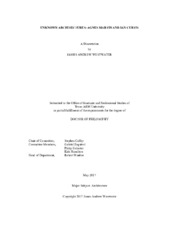| dc.description.abstract | This study focuses on the affective role of the built space of artistic production––the studio, the writing room, the rehearsal space, and the city––to examine, through the lens of architecture, mechanisms of artistic creativity such as inspiration, insight problem solving, nature, and the sublime. Architecture is defined here as human-built, natural, or conceptual space, place, or object. The romantic image of the suffering artist––the artist who suffers for their art––is well known, but to what extent does an artist make work because of their suffering or despite their suffering? In order to represent both hypotheses embedded in the question, two specific artists were selected for case study.
The Canadian-American artist Agnes Martin (1912–2004) is known for her abstract geometric paintings, writings and lectures, and the decision to turn her back on the New York art scene and move to rural Northern New Mexico where she lived for almost 50 years. Martin overcame schizophrenia to become one of the most successful artists of her generation. The English singer-songwriter-musician Ian Curtis (1956–1980), lead singer of the influential postpunk band Joy Division, lived most of his life in or close to the northern English city of Manchester. Curtis suffered from epilepsy and committed suicide at the age of 23 the day before Joy Division’s first American tour.
The study takes a mixed methods approach, which includes historiography, autoethnography, and hermeneutics, to examine the effect and affect of architecture on the two case study subjects, Martin and Curtis, and how place and space is expressed via Martin’s and Curtis’s work to locate both artist and audience. The study finds that Martin and Curtis were influenced and inspired by their surroundings, as evidenced in their work. Both artists also altered space or place in order to facilitate control and creativity. Last, the artists’ lives and works are reflected back at their respective region or city to bring the effect and affect of architecture full circle. | en |


